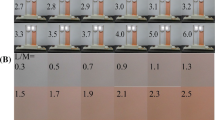Summary
A photometric titration method of microgram concentrations of zinc with dithizone as metallochromic indicator is described. The shape of the titration curve is most favourable for linear end-point extrapolation, if zinc is determined in a 50% ethanolic solution buffered with hexamethylenetetramine to ph 4.8–5.0. The optimum wavelength for the titration is 590 nm. For the concentration range of 2–20μg of Zn2+ the relative error is ±1–2%. Interfering metals such as cadmium and lead may be masked by hydroxyethyldithiocarbamate.
Zusammenfassung
Eine photometrische Titrationsmethode zur Bestimmung von Mikrogrammengen Zink mit Dithizon als metallochromer Indikator wurde beschrieben. Der Knick der Titrationskurve ist für die lineare Extrapolation des Endpunktes sehr günstig, wenn das Zink in 50%iger äthanolischer Lösung bestimmt wird, deren ph mit Hexamethylentetramin auf 4,8 bis 5,0 gepuffert wird. Die beste Wellenlänge für die Titration ist 590 nm. Für den Konzentrationsbereich 2 bis 20μg Zn beträgt der relative Fehler ±1 bis 2%. Störende Metalle wie Cadmium und Blei lassen sich mit Hydroxyäthyldithiocarbamat maskieren.
Résumé
On décrit une méthode de titrage photométrique du zinc en concentration de l'ordre du microgramme, par la dithizone, avec un indicateur métallochromique. La forme de la courbe de titrage se montre très favorable pour l'obtention par extrapolation linéaire du point équivalent, si l'on dose le zinc en solution éthanolique à 50%, tamponnée par l'hexaméthylènetétramine à ph 4,8–5,0. La longueur d'onde optimale pour le dosage est 590 nm. Pour les concentrations de l'ordre de 2–20μg de Zn2+, l'erreur relative est de ±1–2%. Les métaux qui interfèrent, comme le cadmium et le plomb, peuvent être masqués par l'hydroxyéthyldithiocarbamate.
Similar content being viewed by others
References
S. Kotrlý, Mikrochim. Acta [Wien] 1964, 407.
P. Le Goff andB. Trémillon, Bull. soc. chim. France 1964, 350.
S. Kotrlý, Sbornik věd. praci, Vysoká škola chem. technol., Pardubice1964/II, 209.
S. Kotrlý andJ. Vřeštál, Coll. Czechoslov. Chemic. Commun.25, 1148 (1960).
J. Vřeštál, J. Havíř, J. Brandštetr, andS. Kotrlý, Coll. Czechoslov. Chemic. Commun.24, 360 (1959).
S. Kotrlý, Sborník věd. praci, Vysoká škola chem. technol., Pardubice1963/II, 49.
F. Vydra andR. Přibil, Coll. Czechoslov. Chemic. Commun.24, 3103 (1959).
Shiego Hara, Bunseki Kagaku10, 633 (1961).
Tokio Kalo andShinsuke Takei, Bunseki Kagaku2, 208 (1953); Chem. Abstr.47, 12117 (1953).
Author information
Authors and Affiliations
Additional information
Dedicated to Prof. DSc.M. Jureček on the occasion of his 60th birthday.
Rights and permissions
About this article
Cite this article
Řiha, V., Kotrlý, S. & Veselý, J. Photometric microtitrations. II. Mikrochim Acta 54, 342–348 (1966). https://doi.org/10.1007/BF01217460
Received:
Issue Date:
DOI: https://doi.org/10.1007/BF01217460



